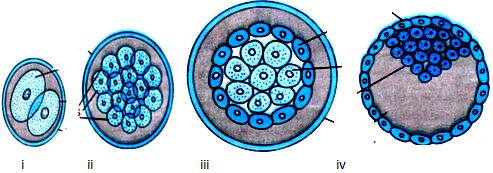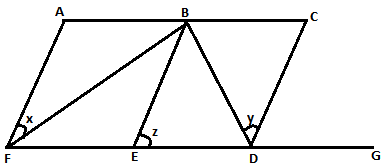12th Grade > Biology
HUMAN REPRODUCTION MCQs
Total Questions : 57
| Page 3 of 6 pages
Answer: Option B. -> Fertility
:
B
Menstruation, also known as a period, is the regular (monthly) discharge of blood and mucosal tissue from the inner lining of the uterus through the vagina.The first menstruation begins at puberty and is called menarche and is a sign of fertility in women.
:
B
Menstruation, also known as a period, is the regular (monthly) discharge of blood and mucosal tissue from the inner lining of the uterus through the vagina.The first menstruation begins at puberty and is called menarche and is a sign of fertility in women.
Answer: Option C. -> i) ⇒ b, ii) ⇒ c, iii) ⇒ e, iv) ⇒ a,v) ⇒ d
:
C
At 9 weeks, the baby's body is fully formed, including ears, toes and fingers complete with fingernails. By 12 weeks, the genitalsfully develop into male or female respectively. By 14 weeks, the baby’s body is covered with a layer of fine hair called lanugo. By 24 weeks, the baby’s organs are fully formed. The foetus now has the face of a newborn baby. If the baby is a boy, his testes will migrate down into the scrotum in the 8th month. By40 weeks, the baby’s head will engage and will be lying on top of the cervix.
:
C
At 9 weeks, the baby's body is fully formed, including ears, toes and fingers complete with fingernails. By 12 weeks, the genitalsfully develop into male or female respectively. By 14 weeks, the baby’s body is covered with a layer of fine hair called lanugo. By 24 weeks, the baby’s organs are fully formed. The foetus now has the face of a newborn baby. If the baby is a boy, his testes will migrate down into the scrotum in the 8th month. By40 weeks, the baby’s head will engage and will be lying on top of the cervix.
Answer: Option A. -> Germinal stage, Implantation stage, Developmental stage
:
A
The time during which a young animal grows inside its mother is known as gestation.There are three general phases of gestation. The germinal stage is the period of gestation from fertilization or conception, when the egg meets the sperm, to implantation of the embryo in the uterus. The embryonic stage of gestation is the period after implantation, during which all of the major organs and structures within the growing mammal are formed. Once the embryo is fully formed, it expands, grows, and continues to develop in what is known as the foetal development stage. This is when the mother has major physical changes and becomes visibly pregnant.The foetal development stage concludes at birth.
:
A
The time during which a young animal grows inside its mother is known as gestation.There are three general phases of gestation. The germinal stage is the period of gestation from fertilization or conception, when the egg meets the sperm, to implantation of the embryo in the uterus. The embryonic stage of gestation is the period after implantation, during which all of the major organs and structures within the growing mammal are formed. Once the embryo is fully formed, it expands, grows, and continues to develop in what is known as the foetal development stage. This is when the mother has major physical changes and becomes visibly pregnant.The foetal development stage concludes at birth.
Question 24. Match the figures with the respective descriptions.


- Daughter cells that are formed are known as blastomeres.
- There is no growth phase between divisions during cleavage.
- Mammalian blastula that contains two distinct cell lineages.
- Inner cell mass becomes the embryo itself and trophoblast cells help implantation in the uterine wall.
Answer: Option C. -> i) ⇒ 2, ii) ⇒ 1, iii) ⇒ 4, iv) ⇒ 3
:
C
The single-celled zygote undergoes cleavage to form 2 cells. Its called cleavage becauseunlike normal mitosis, there is no growth phase between divisions. The embryo further divides to form 4 cells, which divide to form 8 and then 16 cells, and so on. These daughter cells that are formed are known as blastomeres. Once the embryo has reached 8 to 16 blastomeres, it is known as a morula. The morula is the first embryonic stage where mammalian cells can be categorized into internal or external. The internal cells called the inner cell mass or ICM will eventually become the embryo itself and its surrounding membranes, whereas the external cells, called trophoblast cells play a key role in the process of implantation in the uterine wall. A blastocyst is a mammalian blastula that contains two distinct cell lineages. In the blastocyst, the trophoblast cells remain in a single outer layer surrounding the blastocoel, and the cells of the ICM form a mass of cells on the inner surface on one side of the blastocyst.
:
C
The single-celled zygote undergoes cleavage to form 2 cells. Its called cleavage becauseunlike normal mitosis, there is no growth phase between divisions. The embryo further divides to form 4 cells, which divide to form 8 and then 16 cells, and so on. These daughter cells that are formed are known as blastomeres. Once the embryo has reached 8 to 16 blastomeres, it is known as a morula. The morula is the first embryonic stage where mammalian cells can be categorized into internal or external. The internal cells called the inner cell mass or ICM will eventually become the embryo itself and its surrounding membranes, whereas the external cells, called trophoblast cells play a key role in the process of implantation in the uterine wall. A blastocyst is a mammalian blastula that contains two distinct cell lineages. In the blastocyst, the trophoblast cells remain in a single outer layer surrounding the blastocoel, and the cells of the ICM form a mass of cells on the inner surface on one side of the blastocyst.
Answer: Option B. -> (i) Lactiferous duct (ii) Lobule (iii) Lobe (iv) Acini
:
B
In the given cross section of breast, the parts labelled are lactiferous duct, lobe, lobule and acini respectively. The breast is made up of radially arranged lobes which are further divided into lobules. Each lobule contains many clusters of acini which are lined with milk producing cuboidal epithelium. These cells are responsible for the production of milk.
:
B
In the given cross section of breast, the parts labelled are lactiferous duct, lobe, lobule and acini respectively. The breast is made up of radially arranged lobes which are further divided into lobules. Each lobule contains many clusters of acini which are lined with milk producing cuboidal epithelium. These cells are responsible for the production of milk.
Answer: Option A. -> C - Infundibulum, D - Fimbriae, E - Cervix
:
A
The fallopian tube is about 10 to 20 cm long and extends from the periphery of each ovary to the uterus. The part closer to the ovary is funnel shaped and is called infundibulum. The edges of the infundibulum possess finger like projections called fimbriae which help in collection of the ovum after ovulation. The uterus opens into vagina through a narrow cervix.
:
A
The fallopian tube is about 10 to 20 cm long and extends from the periphery of each ovary to the uterus. The part closer to the ovary is funnel shaped and is called infundibulum. The edges of the infundibulum possess finger like projections called fimbriae which help in collection of the ovum after ovulation. The uterus opens into vagina through a narrow cervix.
Answer: Option D. -> All of the above
:
D
A breast exam, called a mammogram, aids in the early detection and diagnosis of breast diseases in women. Breast cancer can be detected by examining symptoms like a lump in the breasts (self examination under the arm), dimpling of the skin, changes in theshape and size of the breast and nipple. Since breast cancer can also occur due to mutations in BRCA1 and BRCA2 genes, genetic testing of these genes can provide information on the possibility of cancer manifestation.
:
D
A breast exam, called a mammogram, aids in the early detection and diagnosis of breast diseases in women. Breast cancer can be detected by examining symptoms like a lump in the breasts (self examination under the arm), dimpling of the skin, changes in theshape and size of the breast and nipple. Since breast cancer can also occur due to mutations in BRCA1 and BRCA2 genes, genetic testing of these genes can provide information on the possibility of cancer manifestation.
Answer: Option D. -> ii and iv
:
D
Generally one of the two ovaries releases an egg which travels through the fallopian tube. If both the ovaries ovulate in the same cycle, eggs will pass through both the fallopian tubes and if these eggs get fertilised, it results in non-identical twins also called fraternal twins. Fraternal or dizygotic twins develop from 2 separately fertilized eggs usually in 2 separate amniotic sacs. Each amniotic sac will have its own placenta and supporting structures. Identical or monozygotic twins may or may not share the same amniotic sac.
:
D
Generally one of the two ovaries releases an egg which travels through the fallopian tube. If both the ovaries ovulate in the same cycle, eggs will pass through both the fallopian tubes and if these eggs get fertilised, it results in non-identical twins also called fraternal twins. Fraternal or dizygotic twins develop from 2 separately fertilized eggs usually in 2 separate amniotic sacs. Each amniotic sac will have its own placenta and supporting structures. Identical or monozygotic twins may or may not share the same amniotic sac.
Answer: Option B. -> Inguinal hernia
:
B
Aninguinal herniaoccurs when tissue, such as part of the intestine, protrudes through the inguinal canal.Most cases of inguinal hernia happen because the canal does not close as it should before birth. This leaves a weak area in the belly muscle. Inguinal hernia can lead to serious complications like inability to pass stools and eventually cutting off blood supply to the intestine. In such conditions a simple hernia surgery known as hernioplasty is performed involving the placement of a reinforcing mesh to solve the problem.
:
B
Aninguinal herniaoccurs when tissue, such as part of the intestine, protrudes through the inguinal canal.Most cases of inguinal hernia happen because the canal does not close as it should before birth. This leaves a weak area in the belly muscle. Inguinal hernia can lead to serious complications like inability to pass stools and eventually cutting off blood supply to the intestine. In such conditions a simple hernia surgery known as hernioplasty is performed involving the placement of a reinforcing mesh to solve the problem.
Answer: Option C. -> Corpus albicans
:
C
Thecorpus albicans (white in colour)is an ovarian scar composed of connective tissue that forms after thecorpus luteumdegenerates. Thecorpus albicansis primarily made of collagen and persists on the ovary for a few months.
:
C
Thecorpus albicans (white in colour)is an ovarian scar composed of connective tissue that forms after thecorpus luteumdegenerates. Thecorpus albicansis primarily made of collagen and persists on the ovary for a few months.


















